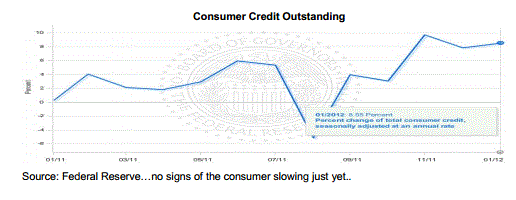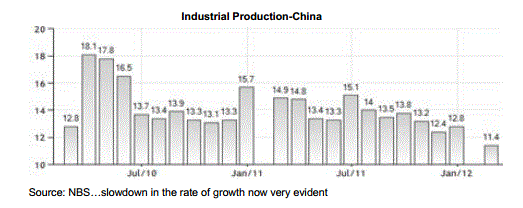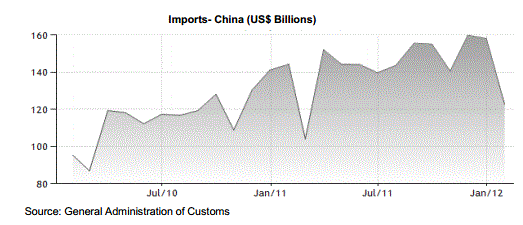International Economy
Eurozone
You could be forgiven for thinking that the Eurozone (EZ)
sovereign debt crisis was over. In recent months media attention
has been conspicuously absent. Indeed EZ credit spreads have almost
returned to some level of normality. Why is this so?
In November 2011, only a handful of months ago, it would not be an understatement to suggest that the situation in the EZ had become critical. Banks had become increasingly reluctant to lend to each other. Yields had again risen on sovereign bonds to rather acute levels - not only in Greece, Spain and Italy - but in France too. When sovereign bond yields rise, several issues arise. Firstly, countries struggle to find demand for new issues (often to replace maturing bond issues) as investors become wary about credit risk. Secondly, even if demand can be found, the cost of repaying bondholders becomes even more expensive, adding to fiscal pressures. Thirdly, higher bond yields flow through to the cost of borrowings generally. Of course what has made the EZ crisis so precarious has been the linkage between banks and sovereigns. Many EZ banks have purchased vast amounts of government bonds from the region and so the risk of a sovereign default causing a cascade of bank failures has been high.
On 8 December the European Central Bank met to discuss measures to stabilise the financial system. Shortly thereafter the ECB president, Mario Draghi, announced that the ECB would provide banks with 3 year loans for the first time in history (normally Long Term Refinancing Operation [LTRO] loans were for only 3 or 6 months) at cost of around 1%, whilst relaxing the rules surrounding what it would accept as collateral. On 22 December the sum of EUR$489 billion was allotted to 523 banks. According to reports, Spanish and Italian banks accounted for around 50% of the total borrowings, while it is understood that French and to a lesser extent, German banks were also significant participants. The success of the 3 year LTRO has been largely credited with reducing the short term risks facing the Eurozone. The reason is because funds were used as follows:
- Many Banks took up the offer to ensure they could cover near term maturities. (ECB records indicate that roughly EUR$720 billion in bank liabilities mature in 2012);
- A lesser percentage of banks used the funds to purchase sovereign bonds offering much higher yields. By buying say Italian bonds at 6.5% but only paying 1% in interest, they could profit from the facility. The demand that this created for sovereign bonds reduced the yields and therefore risks for sovereigns.
So while the 3 year LTRO was intended as a liquidity measure to prevent near term bank failures, it also had the effect of reducing sovereign bond yields and hence short term sovereign default risk as well. Globally, this has led to a rally on sharemarkets.
Nevertheless, to suggest that the 3 year LTRO is some sort of magic bullet is fanciful. Whilst it has provided some short term relief, these measures have not addressed the fundamental problem of restoring economic growth in the affected areas to prevent the debts and deficits from getting worse. The suggestion that growth may be spurred by cheap loans to companies and individuals is unlikely. This is because the EZ is facing a solvency crisis not a liquidity crisis. Companies and/or individuals won't borrow if they are not confident about their prospects. This confidence can only be returned by reducing existing debts and restoring economic growth. As we have said before, we fail to see how this can happen without the PIIGS undergoing significant structural reforms to restore labour market and industry competitiveness. To expedite change, either a large devaluation in the Euro or a selective exit from the EU (probably Greece – which would allow them to return to a heavily devalued national currency) would greatly assist.
In conclusion, the 3 yr LTRO has bought the EZ more time to solve its significant financial problems. We also expect a marginal improvement in confidence to translate into a less severe recession for the region than we originally anticipated.
United States
With China slowing and the EZ all but in a recession, the United
States has been very much the saviour of the global economy in
recent months. Recent data releases have been somewhat more mixed.
Positives have been as follows:
- Consumer credit was up 8.6% in January which indicates an increased confidence in consumer spending.

- This was reflected in a solid February retail sales result, up over 1% on January and up 6.28% over the year.
- The Thomson Reuters/University of Michigan's final index of consumer sentiment in February edged up to 75.3, this is despite an 8.8% rise in fuel prices since the start of the year.
Less inspiring data has been as follows:
- Industrial production in February was flat, although it remains up 4% over the year. Contribution from mining negatively impacted the result. The January figure was revised up from flat to 0.4%.
- The unemployment rate held steady at 8.3% in February after a number of months of falling.
- One of the leading indicators for activity the ISM Purchasing Managers Index fell from 54.1 to 52.7 in February, which indicates a slowdown in the rate of growth (a reading below 50 indicates a contraction).
On balance we believe the recovery in the United States remains very much alive. While the initial stages of the recovery were driven predominantly by the business sector taking advantage of low labour costs and a low US dollar, the recovery has now most definitely been joined by the consumer who is showing an increased willingness to borrow and spend. Of course, headwinds remains in the form of EZ uncertainty, looming fiscal austerity (to reduce the huge government debt), higher oil prices and a still very much stagnant property sector, all of which will ensure growth remains below trend.
China
Latest economic data confirms the slowdown in China's
economy:
- Industrial Production in China expanded 11.4% in February (year on year), which is well below the average rate of 13.46% achieved from 1990 until 2010.

- Retail Sales in China increased 14.7% in February, year on year, which is moderately below the recent average of 17.29%.
- Leading manufacturing indicators such as the HSBC Purchasing Managers' Index (PMI)remain subdued (registered 49.6 in February, but up from 48.8 in January)
- Fixed asset investment has also began to cool somewhat, up only 21.5% in February from a year earlier.

With the rate of growth in both exports and imports declining in recent months, it is clear that the slowdown is evident economy wide. While the government has reduced its GDP target for 2012 to only 7.5%, the government retains scope to stimulate the economy via monetary or fiscal policy initiatives if growth does slow by more than anticipated.
Japan
The outlook for Japan remains broadly positive. Reconstruction
spending will continue to boost domestic demand while the
improvement in the United States economy will provide some impetus
to the large export sector, offsetting the decline in demand likely
from China. Overall, this should translate into modest growth of
around 2% in 2012.
Related articles...
- Australian Economy - Economic & Market Outlook - As at 31 March 2012
- Australian Equities - Market Outlook - As at 31 March 2012
- International Equities - Market Outlook - As at 31 March 2012
- Australian Real Estate Investment Trusts (Listed Property or "AREITs") - Market Outlook - As at 31 March 2012
- Fixed Interest - Market Outlook - As at 31 March 2012
This publication is issued by Moore Stephens Australia Pty Limited ACN 062 181 846 (Moore Stephens Australia) exclusively for the general information of clients and staff of Moore Stephens Australia and the clients and staff of all affiliated independent accounting firms (and their related service entities) licensed to operate under the name Moore Stephens within Australia (Australian Member). The material contained in this publication is in the nature of general comment and information only and is not advice. The material should not be relied upon. Moore Stephens Australia, any Australian Member, any related entity of those persons, or any of their officers employees or representatives, will not be liable for any loss or damage arising out of or in connection with the material contained in this publication. Copyright © 2011 Moore Stephens Australia Pty Limited. All rights reserved.


